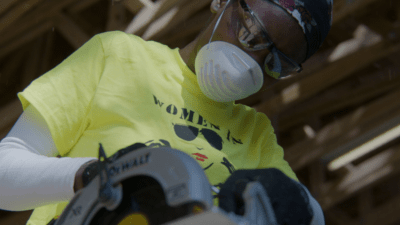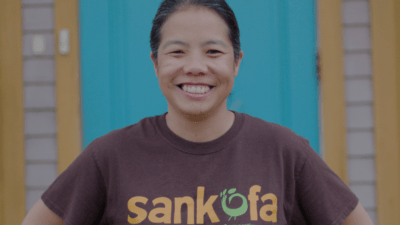Home care workers—individuals who provide caregiving services in the home, most often to seniors and people with disabilities—are among the fastest growing occupations in the country, projecting to add 1.1 million new jobs in the decade between 2019-2029 to meet the demands of an aging American population. These jobs are primarily low-wage, with median hourly wages and inconsistent hours leading to annual earnings of less than $20,000.
Eighty-seven percent of the 2.3 million home care workers in the U.S. are women, 62% are people of color and one in four are immigrants. Training and advancement in the long-term care industry are inconsistent and often minimal. The lack of opportunity, low wages and poor job quality all contribute to high turnover rates. COVID-19 has only heightened the precarity of the health care workforce, creating a greater sense of urgency in improving job quality and opportunities for workers in the field.
WKKF grantee Health Career Advancement Program (H-CAP)—a labor management organization with a unique position and role in the workforce development field as it pertains to direct care workers and the long-term care industry—builds on its relationships with employers, workers, training and education leaders, and workforce development practitioners to work with employers, unions and workers and deploy high-quality training to support the health care industry at a time of unprecedented system transformation.
Recently, with WKKF funding, H-CAP established the Center for Equity and Job Quality in Long Term Care—or the Center for Equity—a national hub for advancing innovative workforce policy and fostering narrative change in long-term care. Their work focuses on women, immigrant, Black, Indigenous and other people of color in the caregiving workforce, confronting the links between systemic, racial and gender inequities and poor job quality in order to move systemic change to improve jobs for health care workers.
WKKF recently sat down with Daniel Bustillo, H-CAP’s executive director, to dive deeper into H-CAP’s work and understand how these training programs support workers, create a pipeline of well-trained staff for employers and ensure that health care remains a force for economic prosperity.
WKKF: H-CAP’s strength is in the intersectionality of its work between racial equity, health equity, employment equity and education equity. Can you talk a little bit about how these intersections work?

Bustillo: If we look at the composition of the health care workforce, occupational segregation is not a new issue. In fact, if you look at the history of workforce training partnerships that we have across the country, the oldest one is situated in New York and is a direct outgrowth of the civil rights movement when Black health care workers were over-represented in lower-wage occupations and underrepresented as you move up the wage scale into higher paying occupations.
The demographic makeup of the caregiving workforce is no coincidence. It’s important to acknowledge that it is a cycle caused by the racialized and gendered nature of caregiving, and it’s a direct result of a history that’s rooted in the institution of chattel slavery and intentional exclusionary policies.
Today, when we look at who composes the lower-paying occupations—such as home care and certified nursing assistants (CNAs)— those are the individuals who primarily compose our workforce, and they are mostly Black and Brown women. The demographic composition steadily changes as you go up the occupational ladder in health care.
It is important to facilitate career advancement opportunities for individuals in occupations at a lower wage to deal with the racialized occupational segregation issues that we have in health care.
Daniel Bustillo
WKKF: What are some supports you provide alongside your training programs?
Bustillo: Child care is one support. The pandemic has definitely shown a hard spotlight on how important the caregiving infrastructure is, and as part of that, child care is essential.
If we think about the importance of child care in the context of workforce development, we certainly know that, particularly when we’re working with adult working learners as well, there are a variety of supportive services that are more important in terms of facilitating success for workers. For some parents, this means a child care infrastructure that allows workers to take the necessary time away from their families and home-life responsibilities to be able to participate in training and professional development opportunities. Access to high quality child care makes a huge difference in the context of facilitating working adult learner success.
WKKF: How has COVID-19 affected your work and the health care sector writ large?
Bustillo: Caregivers and health care workers have rightfully been lauded as heroes throughout the pandemic, but oftentimes unfortunately are not treated as such. There are some real, severe and long-lasting impacts—and a lot of evidence coming out related to this—on the health care workers and the trauma and stress that they’ve experienced as caregivers during the pandemic.
In terms of the provision of our services, COVID-19 has obviously had a huge impact. There was a mass transition to remote services and figuring out how to support individuals. There were cascading effects throughout the continuum of educational partnerships as well, as we transitioned to digital learning. This brought about equity issues of digital literacy because we’re working with a majority of Black and Brown individuals—mostly women, and many immigrants.
Digital literacy in and of itself is not sufficient because we have real, digital inequity issues. Many of the health care workers that we work with don’t have the necessary equipment to be online. Many do not have access to Wi-Fi or broadband. Folks who have been fortunate enough to transition rather seamlessly to working at home take that access for granted. But certainly, we cannot take it for granted in thinking about the health care workers that we support in terms of educational pursuits.
WKKF: WKKF funds H-CAP’s Center for Equity – share a bit more about that work.
Bustillo: The Center for Advancing Racial Equity and Job Quality in Long-Term Care—or the Center for Equity—intentionally centers women of color, many of them immigrants, to confront the links between systemic racial and gender equity and poor job quality in long-term care. At the Center for Equity, we work with a diverse group of advisory board stakeholders to engage in narrative change, policy and thought leadership in service of building the equitable caregiving system our nation needs.
The pandemic has raised the collective consciousness to the fact that caregiving is an essential infrastructure.
Daniel Bustillo
In this moment we have a long overdue opportunity for serious investment in long-term care: roughly $400 billion in home and community-based services in President Biden’s American Jobs Plan. The Center for Equity is in a unique position at this time to bring together traditionally disparate stakeholders with the intention of advancing race and gender equity and center the workers most directly impacted by inequity and make this opportunity work for them. We’re facilitating multiple partnerships to collaborate across silos; identifying opportunities, tools and resources; and helping to build a social narrative to advance policy change in service of building a more equitable caregiving system.








Comments